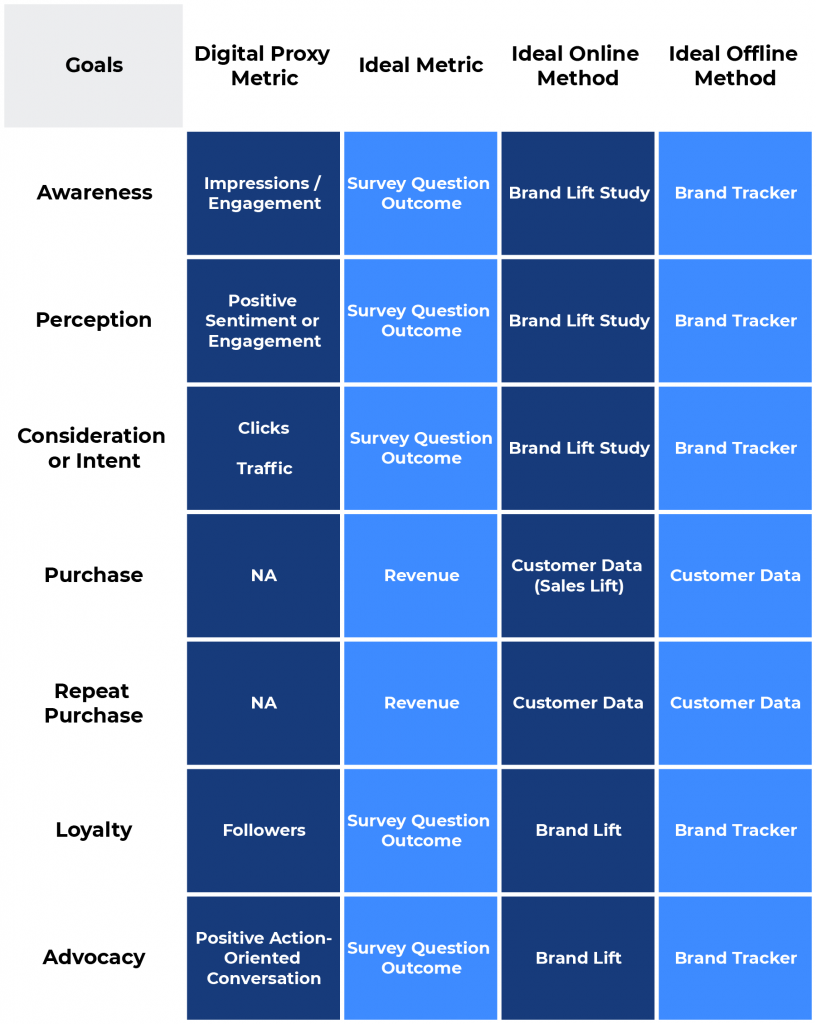When it comes to influencer marketing, there is no one way to measure success. A successful influencer marketing campaign depends on what part of the retail marketing funnel you are in and, subsequently, the campaign goals.
The first, and most important, step in any influencer marketing campaign is to identify the end-goal of the activation. For example, are you launching a new product and want to generate awareness around your brand? Or does your brand already have a great deal of awareness around it and now you are trying to drive sales for a new product?
The second step is to assess the influencer marketing measurement methodology, which usually corresponds with the campaign’s total investment, as well as your risk tolerance. For example, for smaller campaigns with smaller investments, digital proxy influencer marketing metrics usually suffice. For larger campaigns with significant investment, more sophisticated methodologies like brand lift or sales lift studies may be required.
To help you better understand how to measure whether your influencer marketing campaign was a success or not using available influencer marketing metrics, we’re going to break down each part of the retail marketing funnel and discuss what influencer marketing benchmarks brands should focus on to help them determine an influencer marketing campaign’s success.
Phase 1: Building Awareness
During the awareness phase, retailers should focus on top-of-funnel influencer marketing metrics, such as:
- Reach and Impressions:
- Reach: the total number of people who see your content
- Impressions: the number of times your content is displayed
- Engagement: likes, shares, comments, and views
- Brand mentions: use social listening to determine how many people are talking about your brand during your campaign
Phase 2: Consideration
Now that users are aware of your brand, you want them to consider making a purchase. The best way to measure whether consumers are considering your brand is to measure the following:
- Traffic to website:
- Measure the total number of clicks, Click Through Rate (CTR), or Cost per Click (CPC).
- Follower growth on your O&O accounts:
- Map your campaign dates to any spikes in the audience for your owned and operated account(s).
- Time-spent on a website:
- Use Google or Adobe Analytics to track how long users are spending on your site. The longer they stay on your site, the greater the consideration for purchase is.
Phase 3: Conversion
Now that we’ve established users are considering your brand, we want to measure how many of them are following through on that consideration with a purchase. This is undoubtedly the most difficult part of the funnel to measure, as there is no way to know for sure that the money you spent paying an influencer to promote your brand has directly led to a customer’s purchase. However, there are steps you can take to capture as much of this influencer marketing purchase data as possible.
The most important influencer marketing measurement tools to use for analysis are as follows:
- Unique tracking links:
- Use affiliate links and UTM parameters to measure the traffic to your website associated with a specific influencer.
- Coupon or promo codes:
- Give your influencers unique coupons or promo codes for their followers to use when making a purchase so that you can directly associate that purchase with the influencer’s post.
- Isolated marketing effort sales:
- With isolated marketing, you can get a better understanding of your influencer marketing sales ROI by eliminating as many outside factors as possible. With this method, you choose one product (ideally a brand-new product) that you only advertise via influencer marketing for a set period of time (ideally 3-4 weeks). This will allow you to make the assumption that the majority of sales for this test product came from awareness via influencers’ posts.
There will always be those special circumstances in which users went to your website for one product and just so happened to see this product, or they went to a store and saw it on a shelf. But chances are, the majority of sales for this test product will be a direct result of your influencer marketing efforts.
Phase 4: Loyalty
Now that customers own your product, you want them to be loyal to your brand and come back for more. The best way to measure loyalty when it comes to influencer marketing metrics is with the following:
- Engagement rate consistency (or improvement):
- All brands should develop internal influencer marketing benchmarks to trace your brand’s progress.
- Repeat customer sales during the influencer marketing campaign.
- Multi-product purchases during the campaign:
- Are customers seeing your ad for one product and purchasing it in addition to another product from the site?
Phase 5: Advocacy
The last phase of the retail influencer marketing funnel is advocacy. The best way to measure advocacy via social media is with the following influencer marketing metrics and tools:
- Social listening:
- Measure brand mentions from unpaid social media during campaign downtime. If users are mentioning your brand when influencers are not posting about it, you know you have advocates that will speak on your behalf, unprovoked.
- Comments and shares on your O&O account posts:
- Customers are likely to recommend brands after having social media interactions with them (so be sure to engage with those comments).
Though it has historically been challenging to prove the impact of influencer marketing campaigns, there is now an array of metrics and tools available to help brands measure results against their goals. We’ve reviewed several options above, but it would be misguided to try and use all of these at once. For assistance navigating the complexities of your brand’s influencer marketing campaign, check out CreatorIQ's Guide to Influencer Marketing Campaigns.
Critically important to best using digital proxy metrics is having historical influencer marketing benchmarks by which to measure the performance of this campaign versus previous campaigns. The key to executing a successful influencer marketing campaign is to identify what part of the retail marketing funnel you are in, tailor your strategy to optimize for those KPIs (Key Performance Indicators), and then measure results for that phase of the funnel. If you continue to keep track of your KPI results for each phase, you will have benchmarks to measure the success of future campaigns.
Metrics Cheat Sheet

